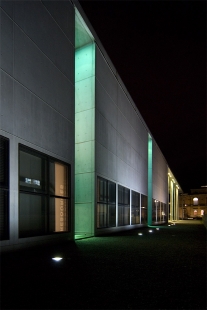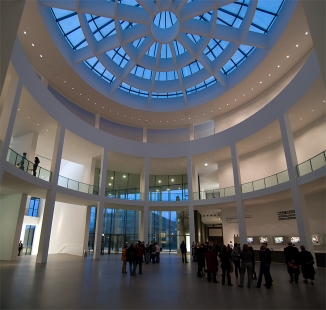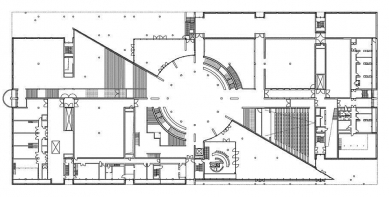
Pinakothek der Moderne

 |
“Where is the entrance?” is one of the key questions to the design. Should the new museums orientate themselves towards the Atle and Neue Pinakothek Museums in the northwest and show their back towards the city centre in the southeast or should they open up towards the old city center?
The design has resolved the question by opening the museum complex on both sides. One entrance is via the large Loggia in the northwest, oriented towards the Alte and Neue Pinakothek Museums. Visitors coming from the city centre can access the building in the southeast, through an entrance that resembles a large gate, followed by a conservatory that leads into the museum.
Both entrances are connected via a diagonal axis across the museum areas. It leads visits coming from both sides directly to the central hall. From the central hall, covered by glass dome, large funnel-shaped staircases that widen towards the upper and the lower levels, take the visitors to three floors.
The unique staircase in the shape of an integrated rotunda forms an extraordinary room-sculpture. Over a length of 100 m and a height of 12 m it ties all parts of the building together. It reaches the Neue Sammlung in the lower ground, then the Architecture Museum, the Staatliche Graphische Sammlung (collection of graphics) and the rooms for changing exhibitions in the ground floor and, finally, the Staatsgalerie Moderner Kunst (gallery of modern art) in the first floor.
 |
The painting gallery in the Staatsgalerie Moderner Kunst located in the upper floor, is a purely day-lit museum with a rooflight grid that illuminates the rooms evently to avoid any shadows or stripes on the walls.
In the actual show rooms, architecture become less apparent: clear-cut day-lit rooms, rectangular or square, in different proportions adapted to the pieces of art, with white plastered walls and a homogenous terrazzo floor.
The Piakothek der Moderne as a powerful sculpture in itself is intended, at the same time, it fits well ito the urban plan and should be experienced as part of a larger museum district.
Thus, the walls surrounding the walls surrounding the area of the second construction phase close the painful gap in the urban landscape of the Maxvorsttadt, thereby, putting the historic street plan bak into place.
By resisting the design of a solitaire building and by limiting the height, the unique osition of the Alte Pinakothek Museum as the centre of the museum district i maintained.
Stephan Braunfels Architekten
0 comments
add comment









































